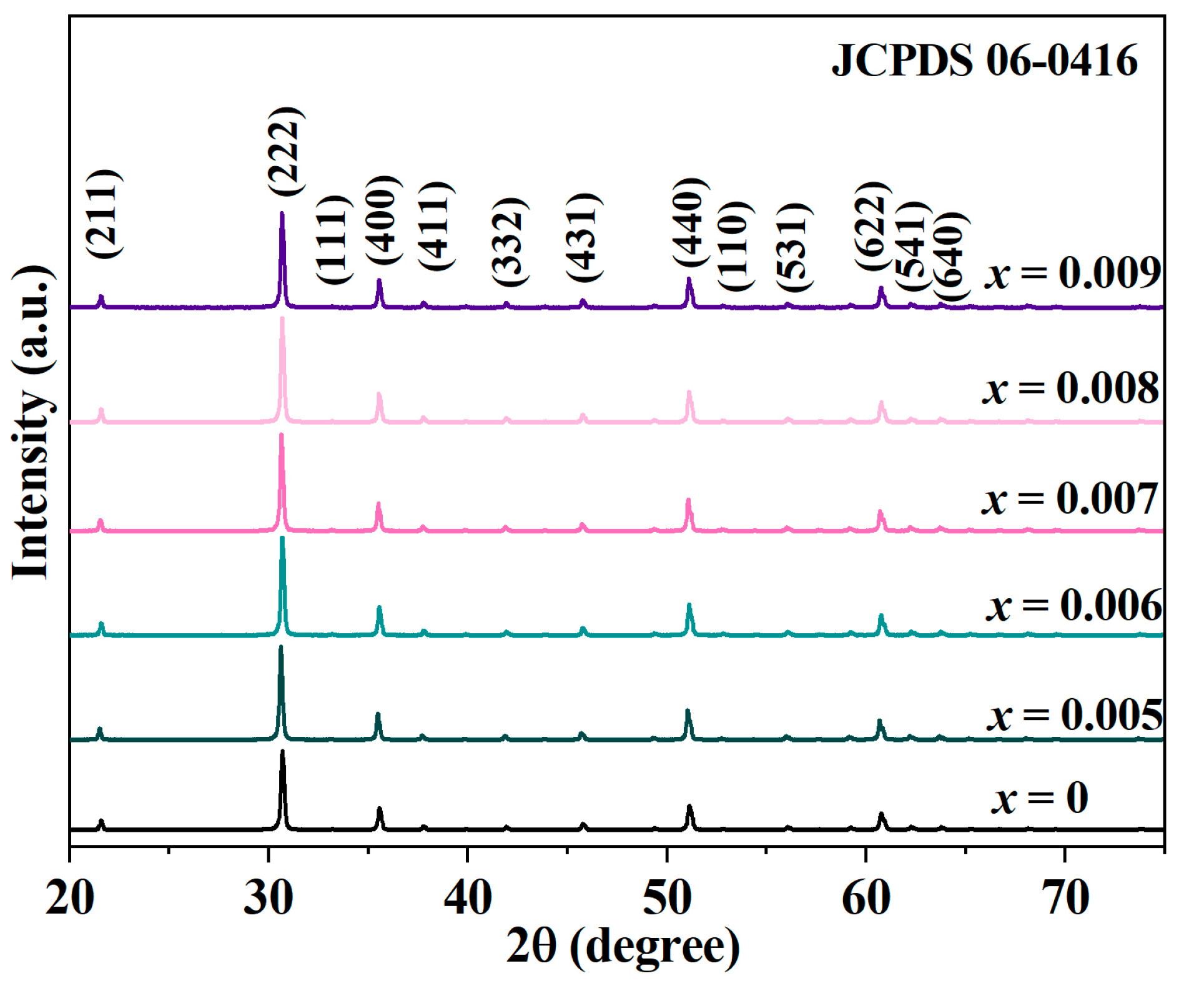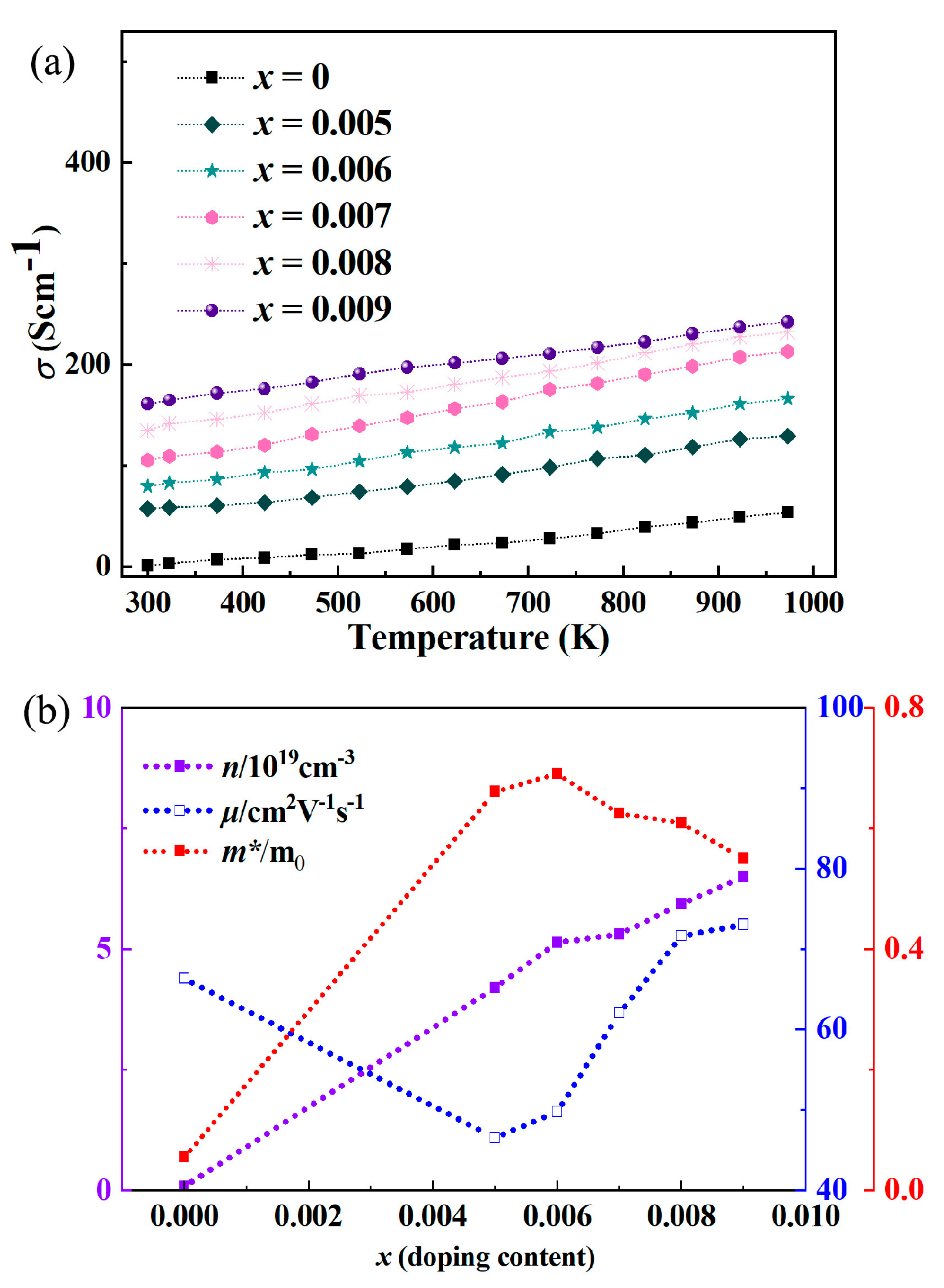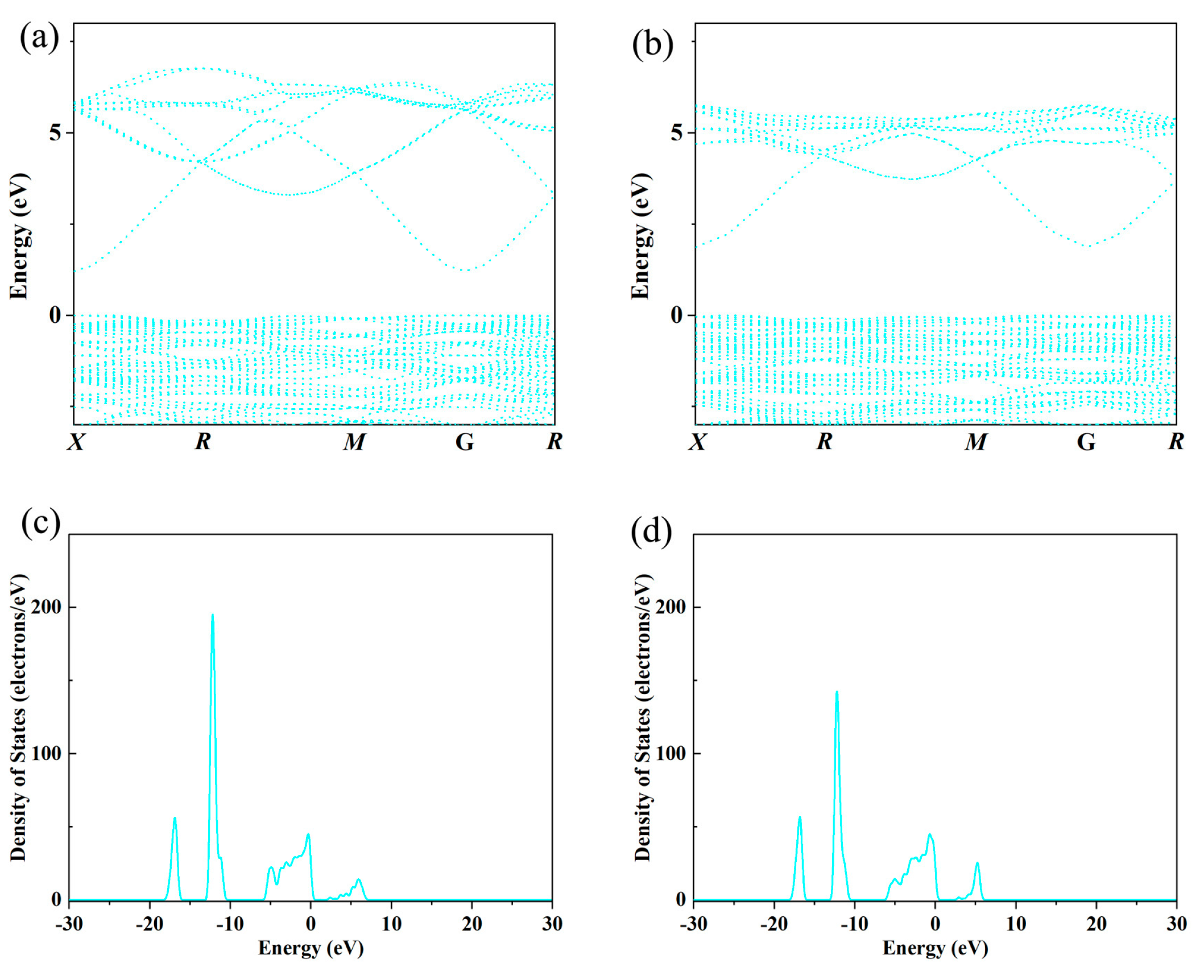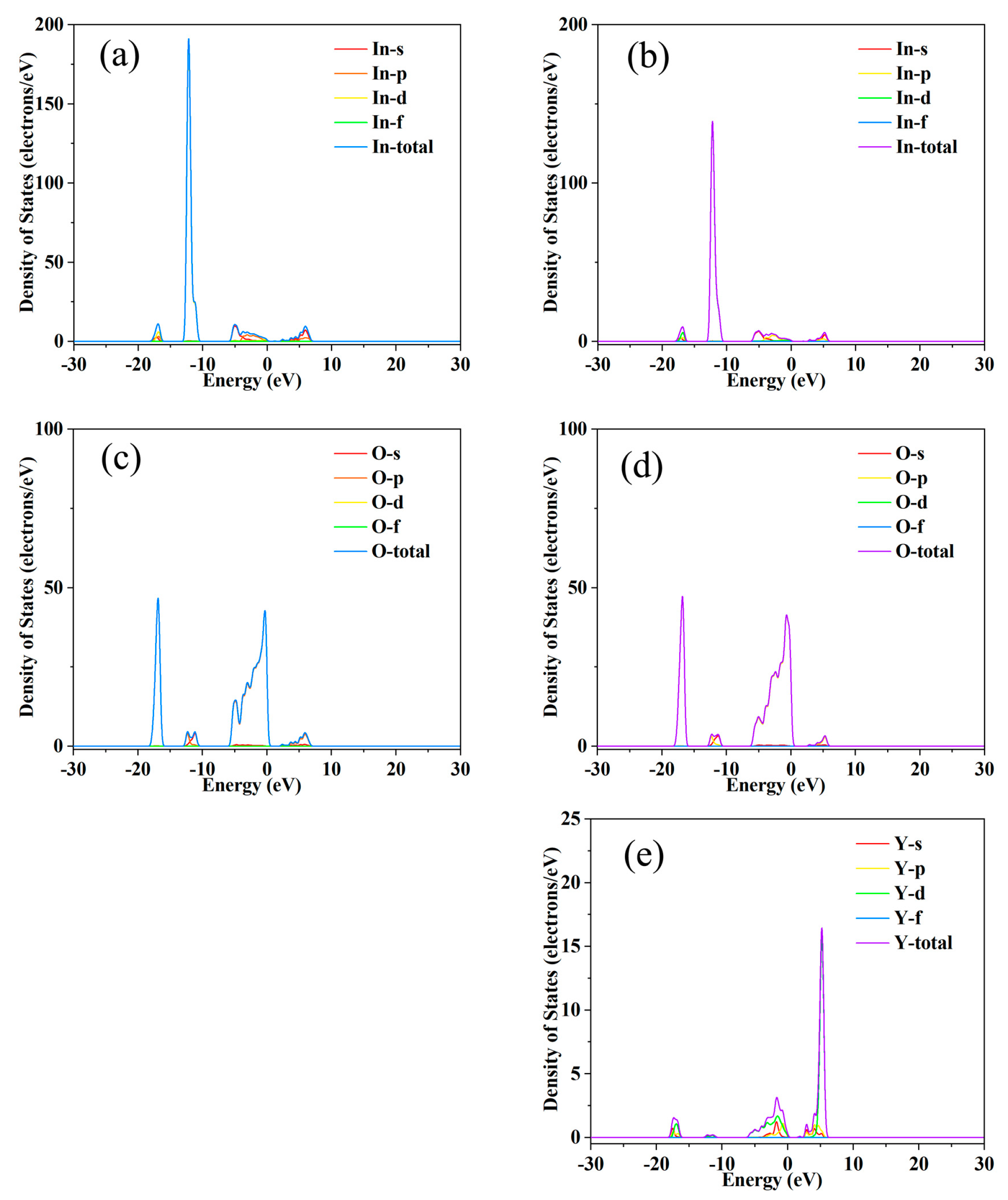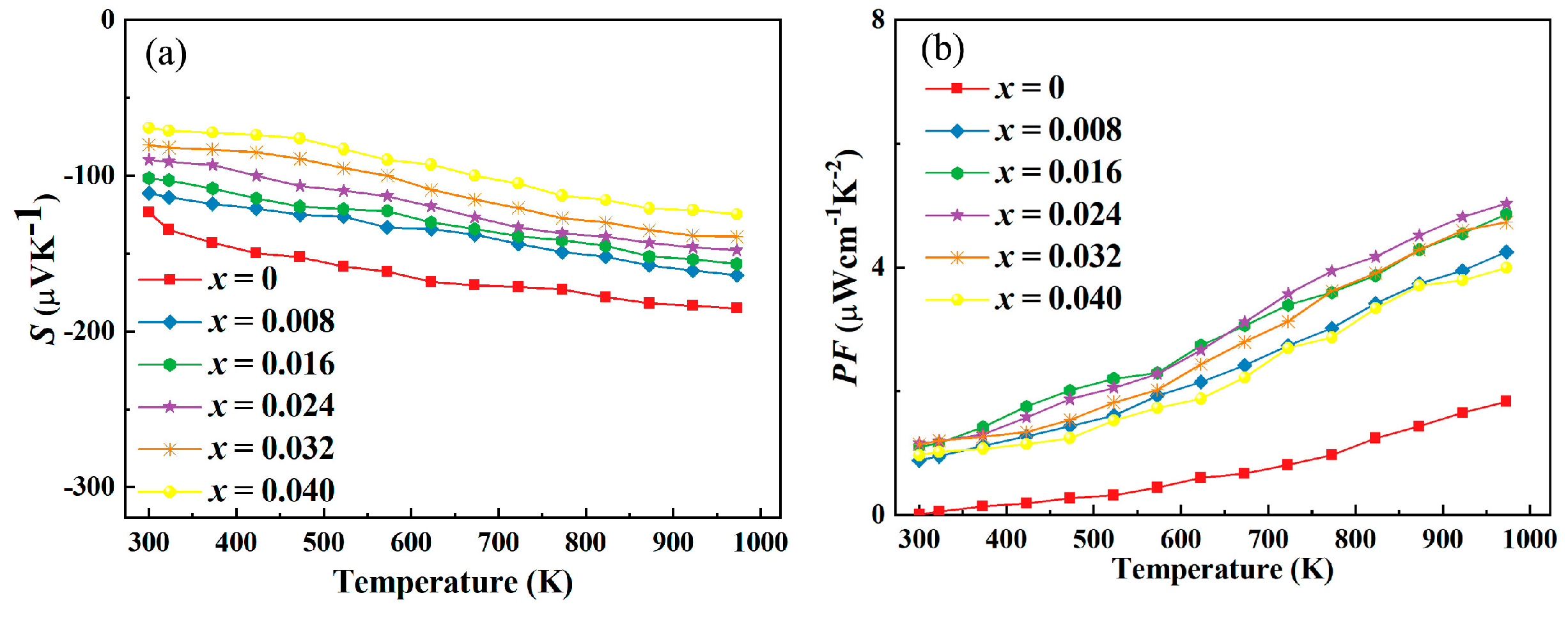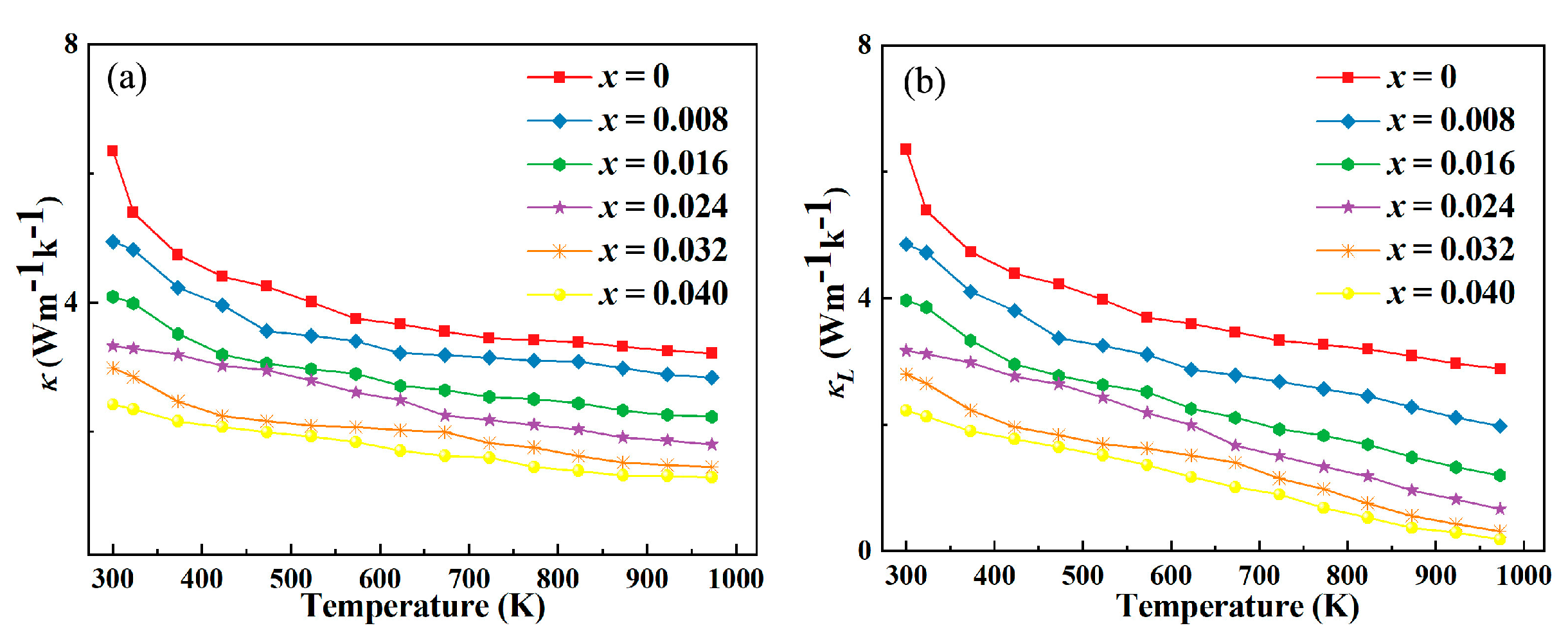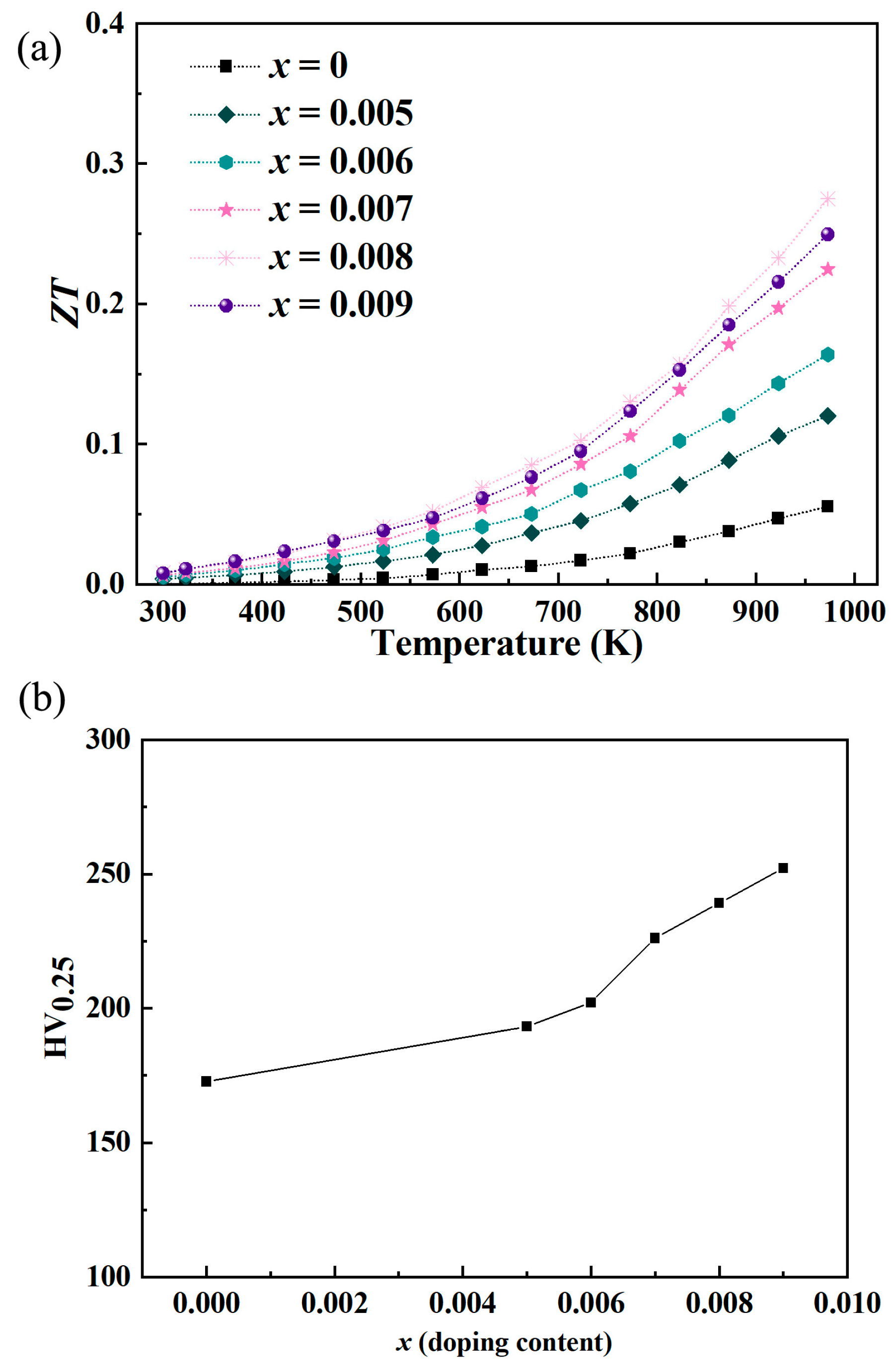1. Introduction
Thermoelectric materials have attracted significant attention in recent decades due to their unique ability to directly convert heat into electricity and vice versa. This property makes them potentially valuable for various applications, such as waste heat recovery and solid-state refrigeration [
1,
2,
3]. Traditional thermoelectric materials like Bi
2Te
3 [
4,
5], PbTe [
6,
7], and SiGe [
8,
9] have shown relatively good thermoelectric performance. However, they also have some limitations. For example, some contain toxic elements, and their high-temperature stability and cost-effectiveness need to be improved. Oxide thermoelectric materials have emerged as an important class of candidates. One of the key advantages of oxide thermoelectric materials is their excellent chemical and thermal stability [
10,
11,
12]. This makes them more sustainable compared to some traditional thermoelectric materials [
13,
14]. In addition, the tunability of oxide materials’ properties through doping and nanostructuring offers great potential for optimizing their thermoelectric performance. For example, by doping different elements into In
2O
3, its electrical conductivity and Seebeck coefficient can be adjusted to enhance the overall thermoelectric figure of merit [
15,
16]. Oxide thermoelectric materials, with their unique advantages, hold great promise for the future development of thermoelectric technology. Although oxide thermoelectric materials possess certain advantages, they also have drawbacks. One major shortcoming is their relatively low electrical conductivity compared to some traditional thermoelectric materials. This leads to a lower power factor and thus restricts the overall thermoelectric performance.
Indium oxide (In
2O
3), as a thermoelectric material, has several advantages. In
2O
3 exhibits a relatively high electrical conductivity. This enables it to conduct electrons effectively, reducing internal resistance and thereby enhancing the power output efficiency during thermoelectric conversion [
17,
18]. Despite its advantages, In
2O
3 thermoelectric material also has some drawbacks in thermoelectric performance. One of the main limitations is its relatively low Seebeck coefficient compared to some other advanced thermoelectric materials. A lower Seebeck coefficient means it generates a less significant thermoelectric voltage for a given temperature difference, which restricts the overall thermoelectric conversion efficiency. Additionally, In
2O
3 has a relatively high thermal conductivity. High thermal conductivity leads to significant heat dissipation and reduces the temperature gradient across the material, which is essential for efficient thermoelectric energy conversion. As a result, a large portion of the heat is conducted away rather than being converted into electricity. Moreover, its figure of merit (ZT) value, which comprehensively evaluates the thermoelectric performance, is not as high as desired. This implies that improvements are needed in both electrical and thermal properties to make it more competitive in practical thermoelectric applications. Current research on the doping of In
2O
3 thermoelectric materials mainly focuses on improving its thermoelectric performance. For example, Ga doping has been studied to introduce nanopore structures, reducing thermal conductivity and enhancing the ZT value [
15,
19]. Other elements doping such as Mo doping [
20], V doping [
21], and Co doping [
22] are also being explored to optimize carrier concentration and phonon scattering, aiming to further improve the efficiency of thermoelectric conversion. However, this kind of doping experiments have a certain degree of blindness and randomness, which has certain limitations on the mechanism research of indium oxide thermoelectric materials.
Yttrium (Y)-doped In2O3 thermoelectric materials exhibit some advantages and innovative features. Y doping can effectively modify the electronic structure of In2O3. By introducing additional electron carriers, it optimizes the electrical conductivity, enhancing the transport of charges and improving power generation efficiency. The innovation lies in its ability to simultaneously manipulate phonon scattering. Yttrium atoms create lattice distortions and point defects, which scatter phonons more effectively, thereby reducing the thermal conductivity. This decoupling of electrical and thermal transport properties is crucial. It allows for a significant increase in the thermoelectric figure of merit (ZT value), making Y-doped In2O3 a promising candidate for advanced thermoelectric applications, such as waste heat recovery systems and solid-state cooling devices, with potential to revolutionize energy conversion and utilization in a more efficient and sustainable manner. The combination of doping experimental studies and first-principles calculations can avoid the randomness and blindness of doping experiments. It significantly improves experimental efficiency. By using first-principles calculations, we can investigate the enhancement mechanism of the thermoelectric performance of indium oxide from a quantum microscopic perspective such as electrons. It helps to understand the interaction between dopants and the host lattice at an atomic level. We can predict the effects of different doping elements and concentrations on the electronic band structure, carrier concentration, and phonon scattering. This approach not only saves time and resources but also provides a deeper understanding and more accurate guidance for optimizing the thermoelectric properties of indium oxide, paving the way for the development of more efficient thermoelectric materials.
3. Results and Discussions
The relative densities were 97.13%, 97.21%, 97.19%, 97.26%, 97.22%, and 97.28% for x = 0, 0.005, 0.006, 0.007, 0.008, and 0.009, respectively.
Figure 1 presents the XRD patterns and lattice constants of Y-doped In
2O
3 thermoelectric materials. Notably, the peaks fully matched the standard card of indium oxide (In
2O
3) (JCPDS No. 06-0416), indicating a high degree of phase purity. With Y doped in the matrix, the phonon scattering may change, potentially reducing the thermal conductivity [
24,
25]. Simultaneously, the modification of the electronic structure can impact the carrier concentration and effective mass, which in turn affect the electrical conductivity and Seebeck coefficient. The absence of impurity peaks validates the successful doping process and high sample quality. Y doping is a crucial factor that intricately correlates with the modifications in the thermoelectric properties of In
2O
3, opening avenues for further optimization and understanding of these materials for enhanced thermoelectric applications.
In the context of Y-doped In
2O
3 thermoelectric materials, as depicted by
Figure 2, an increase in electrical conductivity and carrier concentration is accompanied by a decrease in mobility. Yttrium doping serves as a powerful means to enhance the carrier concentration within the In
2O
3 lattice. In indium oxide (In
2O
3) thermoelectric materials, the increase in charge carrier concentration via isovalent substitution of In
3+ by Y
3+ is mainly attributed to donor levels induced by lattice defects, rather than the valence difference in traditional doping. The ionic radius of Y
3+ (0.090 nm) is larger than that of In
3+ (0.080 nm). After substitution, the surrounding lattice is squeezed. To balance lattice stress, some In
3+ may deviate from lattice sites and form interstitial In. The outer electrons of interstitial In are not bound by lattice bonds and easily escape from atoms to become free electrons. This introduces donor levels in the band gap, significantly increasing electron carriers in the conduction band. This mechanism breaks the conventional understanding that “isovalent doping has no effect on carrier concentration” and realizes carrier regulation through structural defects rather than valence difference, which is a key path for optimizing the thermoelectric performance of In
2O
3-based materials. The substitution of In
3+ ions with Y
3+ ions acts as a source of additional electrons. Y
3+, being a donor impurity, donates extra electrons to the conduction band (the band structure, density of states, and partial density of states are shown in
Figure 3 and
Figure 4). This supplementary electron supply substantially boosts the number of free carriers available for conduction [
26,
27]. As the doping intensity of Y rises, more Y
3+ ions are integrated into the lattice structure, leading to a consistent elevation in carrier concentration. This increased carrier population forms the bedrock for the observed growth in electrical conductivity. In an electric field, a greater number of carriers implies a higher likelihood of electron movement and efficient charge transport, thereby directly translating into improved electrical conductivity. Y doping instigates profound modifications in the electronic band structure of In
2O
3. The alteration in lattice constant due to the incorporation of Y
3+ ions triggers a cascade of changes in the interatomic distances and the potential energy distribution within the crystal. This, in turn, ripples through to the energy bands and the density of states. The modified band structure exerts a direct influence on the effective mass of carriers. A reduction in the effective mass endows carriers with enhanced mobility, as they experience diminished inertia and can navigate more freely within the lattice. Additionally, the perturbed band structure perturbs the position and contour of the Fermi level. This perturbation governs the carrier concentration and the probability of carrier excitation across the energy gap. The net outcome of these band structure modifications is a comprehensive readjustment of carrier properties, which is indelibly linked to the observed electrical conductivity and thermoelectric performance of Y-doped In
2O
3. Temperature emerges as a critical factor that intricately interacts with doping and the inherent material properties of Y-doped In
2O
3. At elevated temperatures, the intensity of lattice vibrations (phonons) surges. These phonons act as scattering agents for carriers, thereby curtailing mobility and, by extension, diminishing electrical conductivity. However, the carrier concentration also exhibits a temperature-dependent behavior. In specific instances, as the temperature ascends, additional carriers can be thermally excited from defect states or impurity levels. This thermal excitation can partially offset the reduction in mobility, presenting a complex interplay between temperature-induced changes in carrier concentration and mobility. In the context of Y-doped In
2O
3, the doping-induced alterations in lattice structure and carrier properties further complicate this relationship. The doping-induced changes can modify the temperature coefficient of electrical conductivity. For example, at particular doping levels, the material may exhibit a more stable electrical conductivity over a broader temperature range, a consequence of the harmonious equilibrium struck between carrier generation, mobility reduction, and lattice scattering. In summation, the observed trends in electrical conductivity, carrier concentration, and mobility of Y-doped In
2O
3 thermoelectric materials are the culmination of a complex web of interactions involving doping-induced carrier concentration increments, the dual-edged impact of lattice distortion on mobility, band structure modifications, and the nuanced interplay with temperature. A profound understanding of these mechanisms not only enriches our knowledge of the material’s fundamental physics but also paves the way for the strategic optimization of doping strategies and material properties. Looking at the electrical conductivity data under different Y doping amounts, as the temperature rises, the electrical conductivity of samples with each doping amount shows an upward trend, and the greater the Y doping amount, the more significant the increase in electrical conductivity. For example, at 300 K, the electrical conductivity of the sample with x = 0 is only 0.55 S·cm
−1, while that of the sample with x = 0.009 reaches 161.02 S·cm
−1, with a significant gap.
The Seebeck coefficient is a fundamental thermoelectric parameter that reflects the thermoelectric potential generated per unit temperature difference. In the context of Y-doped In
2O
3 thermoelectric materials, the observed decrease in the absolute value of the Seebeck coefficient, as depicted in
Figure 5, can be attributed to several interrelated factors. (1) Excessive Carrier Concentration: Y doping leads to an increase in carrier concentration. However, when the carrier concentration becomes too high, it can cause a significant reduction in the Seebeck coefficient. At elevated carrier densities, carriers tend to interact more strongly with each other. These carrier–carrier interactions lead to energy equilibration among carriers, reducing the energy difference between them. The Seebeck effect relies on the energy difference of carriers in the presence of a temperature gradient to generate a thermoelectric voltage. With a diminished energy difference, the magnitude of the thermoelectric voltage generated per unit temperature difference decreases, resulting in a lower Seebeck coefficient. In Y-doped In
2O
3, if the doping level is not carefully controlled, the excessive introduction of carriers can overpower the beneficial effects of other factors and drive down the Seebeck coefficient. (2) Band Structure Degradation: Although Y doping initially modifies the band structure in ways that can enhance the Seebeck coefficient, over-doping or improper doping can lead to band structure degradation. The substitution of In
3+ with Y
3+ ions may introduce disorder in the lattice. This disorder can cause the broadening and flattening of energy bands near the Fermi level. A flattened band structure means a less pronounced variation in the density of states. As a result, the energy filtering effect, which is crucial for enhancing the Seebeck coefficient by preferentially scattering carriers with specific energies, becomes less effective. The weakened energy filtering leads to a more homogeneous distribution of carrier energies, reducing the ability to generate a significant thermoelectric voltage and, consequently, decreasing the Seebeck coefficient. (3) Enhanced Phonon–Electron Interaction: The lattice distortion caused by Y doping not only affects phonon scattering but also alters the phonon–electron interaction. In some cases, the increased scattering of phonons due to lattice distortion can lead to a stronger coupling between phonons and electrons. This enhanced interaction can cause carriers to lose their energy more quickly to the lattice vibrations. As carriers lose energy, their ability to contribute to the thermoelectric voltage generation based on the temperature gradient is compromised. The energy dissipation of carriers to the lattice via phonon–electron interactions reduces the effective energy available for thermoelectric transport, thereby leading to a decline in the Seebeck coefficient. (4) Temperature-Induced Effects: Temperature plays a significant role in modulating the Seebeck coefficient. At higher temperatures, the thermal energy can cause additional scattering mechanisms to come into play. For Y-doped In
2O
3, the lattice expansion with increasing temperature can further exacerbate the lattice distortion already caused by Y doping. This enhanced lattice distortion can disrupt the delicate balance of electronic and phonon properties that are essential for maintaining a high Seebeck coefficient. Additionally, the increased phonon population at higher temperatures can lead to more frequent phonon–carrier collisions, which not only reduce carrier mobility but also interfere with the thermoelectric voltage generation process. The cumulative effect of these temperature-induced changes is a decrease in the Seebeck coefficient, especially at elevated temperatures.
The observed increase in the power factor with the highest value from ~1.833 μW·cm
−1·K
−2 to ~4.983 μW·cm
−1·K
−2, as shown in
Figure 5, can be attributed to several synergistic factors. Y doping effectively modulates the carrier concentration. By introducing an appropriate amount of Y
3+ ions, the number of free carriers in the conduction band is adjusted to an optimal level. This optimization is crucial because it allows for a balance between electrical conductivity and the Seebeck coefficient. At the right carrier concentration, the electrical conductivity is enhanced without overly sacrificing the Seebeck coefficient. The increased number of carriers facilitates better charge transport, leading to an improvement in the overall power factor. In contrast to the situation where excessive carrier concentration might reduce the Seebeck coefficient, in this case, the doping level is carefully controlled to ensure a positive impact on the power factor. The incorporation of Y
3+ ions not only tunes the carrier concentration but also impacts the mobility of carriers. Despite the fact that lattice distortion due to doping can initially introduce scattering centers, the overall effect on mobility can be mitigated. The increased carrier concentration can screen the scattering potential, resulting in a net increase in electrical conductivity. Higher electrical conductivity means more efficient transport of electrical charge in response to a temperature gradient, which directly contributes to a higher power factor. This enhanced conductivity, combined with a relatively stable Seebeck coefficient, leads to an overall improvement in the power factor of Y-doped In
2O
3. Y doping induces modifications in the electronic band structure. These alterations can lead to a more favorable distribution of electronic states near the Fermi level. The adjusted band structure can enhance the effective mass of carriers in a way that benefits both electrical conductivity and the Seebeck coefficient. A well-engineered band structure allows carriers to move more effectively and also contributes to a more pronounced thermoelectric effect.
The thermal conductivity of thermoelectric materials is a critical property that significantly impacts their overall thermoelectric performance. In the case of Y-doped In
2O
3 thermoelectric materials, as represented by
Figure 6, the observed decrease in thermal conductivity can be attributed to several key factors. Y doping induces lattice distortion in the In
2O
3 crystal structure. The substitution of In
3+ ions with Y
3+ ions, which have different ionic radii, disrupts the regular lattice arrangement. This distortion creates numerous scattering centers for phonons, which are the carriers of heat in solids. Phonons experience more frequent collisions and scattering events as they propagate through the distorted lattice. These scattering processes impede the efficient transfer of heat, thereby reducing the thermal conductivity. The enhanced phonon scattering due to lattice distortion is a dominant mechanism contributing to the observed decline in thermal conductivity. As the doping concentration of Y increases, the extent of lattice distortion and, consequently, the phonon scattering probability also increase, leading to a more significant reduction in thermal conductivity. The introduction of Y
3+ ions into the In
2O
3 lattice can generate point defects and dislocations. These imperfections act as additional barriers to phonon propagation. Point defects, such as vacancies or interstitial atoms, disrupt the continuity of the lattice and scatter phonons. Dislocations, which are line defects in the crystal structure, also introduce regions of local lattice strain and distortion. Phonons interacting with these dislocations experience scattering and energy dissipation. The combined effect of point defects and dislocations further inhibits the heat transfer process, contributing to the overall reduction in thermal conductivity. In Y-doped In
2O
3, the formation and density of these defects are influenced by the doping process and can be optimized to achieve the desired reduction in thermal conductivity for improved thermoelectric performance. Y doping may lead to the formation of nanostructures or influence the grain size and boundaries in the material. Nanostructures, such as nanoparticles or nanocrystals, introduce additional interfaces within the material. These interfaces act as effective phonon scattering sites. Grain boundaries, which separate different crystalline regions, also scatter phonons. The increased number and area of these interfaces due to nanostructuring or refined grain structure enhance the phonon scattering efficiency. Phonons find it more difficult to traverse across these interfaces, resulting in a decrease in thermal conductivity [
24,
28,
29]. This effect can be harnessed to decouple the thermal and electrical transport properties in thermoelectric materials, as reducing thermal conductivity while maintaining or enhancing electrical conductivity is crucial for improving the thermoelectric figure of merit. Y doping can also modify the interaction between electrons and phonons. In a thermoelectric material, the movement of electrons and the propagation of phonons are interrelated. The altered electronic band structure due to Y doping can influence the coupling between electrons and phonons. In some instances, the doping may lead to a reduction in the electron–phonon interaction strength. This means that phonons are less likely to transfer their energy to electrons and vice versa. As a result, the heat carried by phonons is less likely to be dissipated through electronic channels, leading to a more efficient confinement of heat within the phonon subsystem and a consequent decrease in thermal conductivity. This modulation of the electron–phonon interaction provides an additional mechanism for controlling the thermal conductivity in Y-doped In
2O
3 thermoelectric materials. When yttrium (Y) is doped into indium oxide (In
2O
3) thermoelectric materials, the decrease in Young’s modulus as shown in
Figure 7 exerts a notable influence on lowering thermal conductivity, which is critical for enhancing thermoelectric performance. Young’s modulus reflects a material’s stiffness. A reduced Young’s modulus indicates weakened atomic bonding strength in the doped system. This weaker bonding enhances lattice vibrations (phonon scattering).
In the case of Y-doped In
2O
3 thermoelectric materials, the observed increase in ZT had the highest value from ~0.055 to ~0.275, as depicted in
Figure 8a. When x = 0.008, the ZT value reaches the maximum in this system, which is one of the key characteristics of thermoelectric performance optimization in this study. From the perspective of carrier regulation, when
x = 0.008, the moderate substitution of In
3+ by Y
3+ makes the carrier concentration of the material in the “optimal transmission range”—it not only avoids the low electrical conductivity caused by insufficient number of carriers at low concentration (
x < 0.008), but also prevents the decrease in mobility caused by enhanced carrier scattering at high concentration (
x > 0.008), realizing the optimal matching between electrical conductivity and Seebeck coefficient. From the perspective of heat transport, the lattice distortion introduced by an appropriate amount of Y doping can effectively scatter low-frequency and medium-frequency phonons, reducing the lattice thermal conductivity. However, when x exceeds 0.008, Y atoms may agglomerate locally, which instead weakens the phonon scattering effect and leads to a rise in lattice thermal conductivity. In addition, the synergistic effect of electrical conductivity, Seebeck coefficient, and thermal conductivity of the material at this concentration makes the ZT value (ZT = S
2σT/κ, where S is Seebeck coefficient, σ is electrical conductivity, T is absolute temperature, and κ is total thermal conductivity) reach the peak. This is highly consistent with the core goal of this study, which is “optimizing the ZT value to improve thermoelectric performance”, and provides a key concentration reference for the subsequent performance regulation of Y-doped indium oxide thermoelectric materials. Y doping leads to an optimized power factor. As discussed earlier, it modulates carrier concentration and mobility, enhancing electrical conductivity while maintaining a reasonable Seebeck coefficient. The power factor, which is the product of the Seebeck coefficient and electrical conductivity, is thus improved. A higher power factor means the material can more effectively convert a temperature difference into electrical power. This directly contributes to the elevation of the ZT value. By carefully controlling the doping level and conditions, the power factor can be tuned to an optimal range, providing a strong foundation for enhancing the overall thermoelectric performance. The decrease in thermal conductivity, as analyzed previously, is another crucial factor. Lattice distortion, point defects, nanostructuring, and modified electron–phonon interactions all work together to impede heat transfer. A lower thermal conductivity ensures that a larger temperature gradient can be maintained across the material. This is vital as the thermoelectric effect relies on a significant temperature difference. With reduced heat dissipation, more of the temperature gradient is available for thermoelectric conversion, thereby enhancing the ZT value. The decoupling of electrical and thermal transport properties achieved through reducing thermal conductivity while enhancing electrical conductivity is a key strategy to boost the ZT value. Y doping-induced modifications in the band structure not only affect the power factor but also influence carrier transport and scattering. The adjusted band structure can optimize the energy distribution of carriers, reducing their scattering and improving their effective utilization for thermoelectric conversion. This fine-tuning of carrier behavior within the material further enhances the overall thermoelectric efficiency and contributes to the increase in ZT. The ability to engineer the band structure through doping provides a powerful means to manipulate the thermoelectric properties and achieve higher ZT values in Y-doped In
2O
3 materials. The enhancement of the dimensionless thermoelectric figure of merit in Y-doped In
2O
3 is a result of the combined effects of optimizing the power factor, reducing thermal conductivity, and engineering the band structure and carrier transport. These factors work in harmony to improve the material’s ability to convert heat into electricity efficiently, making Y-doped In
2O
3 a promising candidate for various thermoelectric applications where high-performance materials are required. The increase in Vickers hardness of Y-doped In
2O
3 thermoelectric materials, as shown in
Figure 8b, can be attributed to multiple factors. Y doping induces lattice distortion. The substitution of In
3+ with Y
3+ ions, which have different ionic radii, disrupts the regular lattice arrangement. This distortion leads to an increase in internal stress within the crystal structure. The material’s resistance to deformation under an applied load is enhanced as a result, thereby increasing the hardness. They can act as reinforcing agents, impeding the movement of dislocations and enhancing the overall hardness [
30,
31]. The Vickers hardness of indium oxide thermoelectric material increased from ~172.1 HV to ~252 HV.
